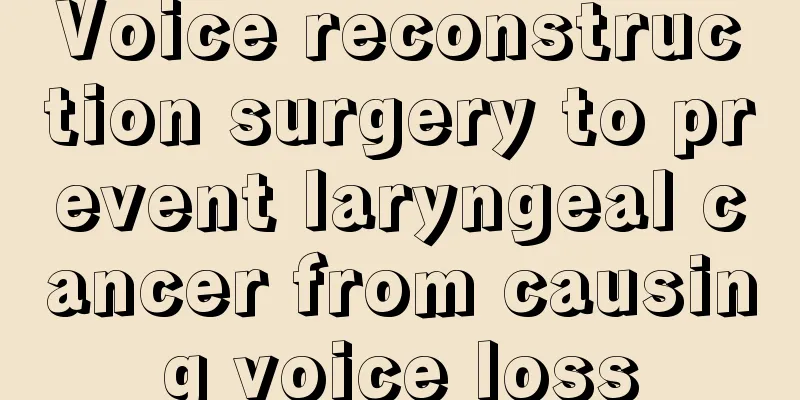Voice reconstruction surgery to prevent laryngeal cancer from causing voice loss

|
59-year-old Mr. Guo has been living alone. His wife passed away early and he has no children. He spends his life farming. Mr. Guo has been smoking for more than 30 years. He thinks smoking is a great pleasure and never thinks of cancer and smoking together. Three months ago, Mr. Guo had hoarseness for several days and even coughed up bloody phlegm. The old man rushed to the hospital. Laryngeal cancer surgery may not save voice After examination, Mr. Guo was diagnosed with advanced squamous cell laryngeal cancer. The tumor had grown all over the right vocal cord in the glottis area, reaching down to the trachea under the glottis, and invading the arytenoid cartilage posteriorly. In order to reduce the chance of recurrence, the doctor planned to perform a total laryngectomy. However, total laryngectomy would cause the patient, Mr. Guo, to lose his ability to speak, and Mr. Guo had no children to take care of him. How could such a helpless and lonely old man face a "speechless" life in the future? Pronunciation reconstruction technology saves Mr. Guo’s “right to speak” In order to enable Mr. Guo to regain the ability to speak and improve his ability to take care of himself, the doctor proposed a treatment plan of "total laryngectomy, anterior cervical skin tracheostomy, and vocal tract reconstruction." First, the laryngeal body and the first tracheal cartilage ring that were severely invaded by the tumor were completely removed, and the surrounding normal blood vessels, nerves, muscles, and mucosa were preserved as much as possible. Then a mucosal flap was cut from the esophagus, and the vocal tract was reconstructed between the patient's trachea and esophagus. Finally, the patient's tracheal opening was sutured to the skin opening in the front of the neck to complete the anterior cervical tracheostomy. After 5 hours of hard work, the operation was successfully completed. After the operation, Mr. Guo still needed a period of recuperation. Half a month later, the dilator tube was removed. Mr. Guo blocked the opening of the trachea in front of his neck with his fingers and exhaled forcefully. The air flowed from the lungs through the trachea, vocal tubes, and esophagus into the pharyngeal cavity. The pharyngeal mucosa vibrated and he made an "ah" sound. Mr. Guo resumes his “audio” life When he heard his own voice, Mr. Guo was very excited and his eyes were filled with tears. After a period of adaptation and practice, Mr. Guo could speak simple words and sentences, and his words were loud and clear. The doctor was surprised and happy to see Mr. Guo casually greet others in the ward. |
<<: Characteristics of TCM in treating middle and late stage laryngeal cancer
>>: How to confirm the diagnosis of liver cancer
Recommend
Symptoms of prostate cancer are most likely to manifest as pain
Prostate cancer is a type of cancer. After the on...
Why do I have a bloated stomach and keep farting at night? Is it colon cancer?
Stomach bloating and frequent farting at night ar...
What kind of exercise is suitable for lung cancer
We often hear doctors or family members tell us t...
What can I eat to eliminate yellow crane spots
Yellow crane spots, also known as chloasma, are a...
What causes acne on the hairline behind the neck?
Having pimples on the face is already very annoyi...
Can drinking black tea lower blood sugar?
Blood sugar is the sugar in the serum, generally ...
Can people with nephroblastoma live forever
Nephroblastoma is a disease that usually occurs i...
How to clean white leather shoes
The characteristic of white leather shoes is that...
What causes wound scars to turn red?
I believe everyone has noticed that if there is a...
Surgery is the main treatment for gastric cancer
The surgical method for gastric cancer should be ...
What to do if the lymphatic gums are swollen
Lymph nodes are the body's immune organs. Whe...
Glossary of terms for primary liver cancer
Primary liver cancer refers to malignant tumors t...
What kind of fever may be a symptom of liver cancer? How should we prevent liver cancer in our daily life?
It is understood that many people in my country l...
Will high blood pressure during physical examination affect employment?
Nowadays, many companies require employees to und...
Can Moringa seeds lower blood pressure?
Moringa seeds are very natural foods with high nu...









